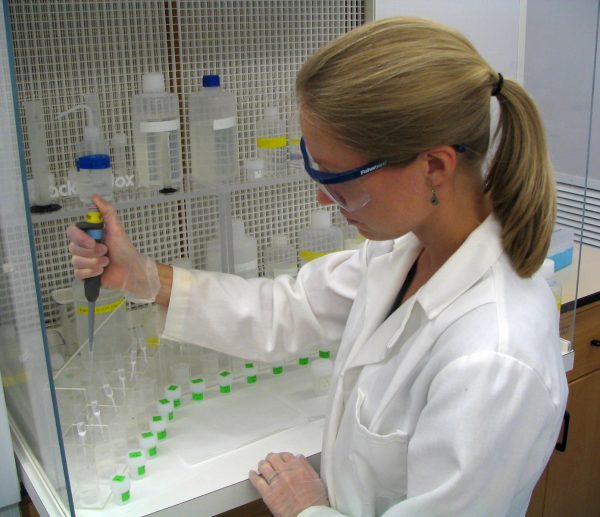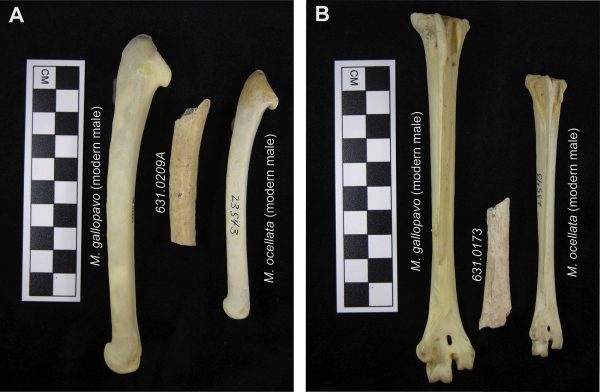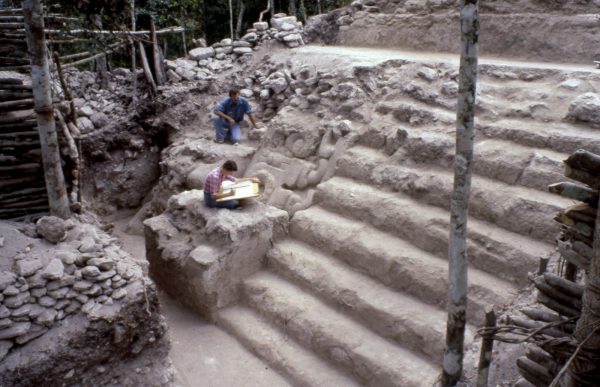As a University of Florida graduate student, one of Erin Thornton’s first assignments was to identify turkey bones from an ancient Mayan archaeological site in Guatemala.

Photo by Dan Thornton
Determined to please her adviser, Thornton thoroughly examined the features of the bones, which dated to the Late Preclassic period from 300 B.C. to A.D. 100. She decided they were remains of a non-local turkey native to central and northern Mexico, Meleagris gallopavo gallopavo, commonly known as the Mexican Turkey.
But unbeknownst to Thornton at the time, her conclusion defied previous archaeological evidence – the species did not belong in the Maya area during the Late Preclassic period. According to the archaeological record, the Maya did not use the non-local Mexican Turkey until about 1,000 years later.
“To be honest, I was so focused on getting the morphological identifications correct to impress my doctoral adviser that I wasn’t necessarily thinking about what species should or shouldn’t be there in the Late Preclassic,” said Thornton, a research associate at the Florida Museum of Natural History on the UF campus and Trent University Archaeological Research Centre in Canada.
Thornton then consulted the Museum’s resident bird expert, ornithology curator David Steadman, who confirmed the identifications. But they needed additional evidence. So Steadman, Thornton and her adviser, curator of environmental archaeology Kitty Emery, collaborated with DNA analysts to verify the bones belonged to the Mexican Turkey, representing the earliest evidence of the species in the Maya world.
The research was published online Aug.9, 2012, in Plos One.
“The turkey is one of the most important food birds in the world – it’s consumed worldwide,” Thornton said. “But we don’t really know much about its origins, when it was domesticated, or what the process of domestication actually was, so our research is kind of filling in some of those unknown areas.”
Archaeologists excavated the ancient turkey bones from a Mayan site in Guatemala in the 1980s and they were stored at the Brigham Young University Museum of Peoples and Cultures until 2004. Their discovery is significant because the pre-Colonial Maya did not use many domesticated animals – while they cultivated domesticated plants, most of their animal protein came from wild resources, Thornton said.
“We might have gotten the timing of the introduction of this species to the ancient Maya wrong by a significant chunk of time,” Thornton said. “The species originates from central Mexico, outside the Maya cultural area. This is the species the Europeans brought back with them to Europe – all domestic turkeys originated from Mexico.”
The discovery of the bones south of the turkey’s natural range shows animal exchange occurred from northern Mesoamerica to the Maya cultural region during the Late Preclassic period from 300 B.C. to A.D. 100.
“This research has consequences for understanding Maya subsistence because they would have had access to a controlled, managed resource,” Thornton said. “The turkey bones came from right within the ceremonial precinct of the site, so these are probably the remains of some sort of elite sacrifice, meal or feast.”
Identifying ancient bones

Photo courtesy of Erin Kennedy Thornton
When Thornton identified the bones from the Mexican Turkey, Meleagris gallopavo gallopavo, she was told to recheck her results because researchers assumed the bones belonged to the native ocellated turkey, Meleagris ocellata. The bones were found in a seemingly ceremonial context and the new evidence means researchers may need to re-examine previously recovered bones, said Florida State University anthropology professor emeritus Mary Pohl.
“This study is extremely significant and I think it opens up a whole new perspective on the Maya and animal domestication,” Pohl said. “I find it especially interesting that these turkey bones are in this very special pyramid context because people often think of turkeys as something to eat, but they were probably making some sort of special offerings of them, which would go along with the fact that they brought them in from a long distance.”
Before researchers were able to identify the turkey by its DNA, Thornton determined the turkey’s identity by comparing its structure with bones of other birds. Steadman pointed out some additional features in the specimens, including underdeveloped quill tubercles that show the turkeys were likely captive, rather than wild, Thornton said.
“If birds are exercising their flight feathers a lot, the tubercles are going to be more pronounced,” Thornton said. “In a captive bird the tubercles are often less developed.”
Thornton said she hopes advances in research techniques will enable scientists to extract further information from the archaeological record.
“I think that DNA in the future probably will tell us quite a bit about turkey domestication in Mesoamerica, but we’re just not there yet,” Thornton said.

Photo courtesy of the Museum of Peoples and Cultures, Brigham Young University
Maya culture
The turkey bones were recovered from the El Mirador archaeological site, one of the largest and most developed Preclassic settlements found in the Maya lowlands. The site contains massive temple complexes, some of the largest Maya architecture ever constructed.
During the Late Preclassic period, the Maya constructed large stone monuments and established long-distance trade networks, Thornton said. Other features characteristic of Late Preclassic Maya civilization include the use of calendars, mathematics and writing.
“Plant and animal domestication suggests a much more complex relationship between humans and the environment — you’re intentionally modifying it and controlling it,” Thornton said.
The domesticated dog was also present in Mesoamerica at the time, but since it was brought to the Americas from the Old World, the Mexican Turkey is the only domesticated animal indigenous to the area, Thornton said.
“The history of animal domestication in the New World is not well-known,” she said. “Documenting how and when turkeys were domesticated will contribute greatly to our understanding of human-animal relationships in the ancient Americas.”
Continuing research
Florida Museum researchers hope a new two-year, $185,000-grant from the National Science Foundation will help answer some of the questions the study has raised about the history of turkey rearing and domestication in Mesoamerica.
“The turkeys were brought in, they weren’t local, but we don’t know if they were brought in and then killed shortly after, used as a trade item or bred on-site after an even earlier introduction,” Thornton said. “The El Mirador study is really just a tantalizing piece of the puzzle and we still have a lot left to learn and explore.”
Researchers will compare captive and wild turkeys to look for differences, as well as explore the possibility the Maya raised captive populations of the local ocellated turkey, a wild species that was never fully domesticated, Thornton said.
“What we might expect is that the captive turkeys would be eating more corn, which was a major food for the Maya,” Thornton said.
The Maya also potentially had other uses for turkeys that may be revealed with further research.
“The Maya used turkeys for food, offered them as ritual sacrifices and feathers were an important part of Maya costumes,” Thornton said. “Their bones also could have provided a raw material for crafting, so they could have made personal ornaments like bone beads.”
Study co-authors include Emery and Steadman, Camilla Speller and Dongya Yang of Simon Fraser University and Ray Matheny of Brigham Young University.
Learn more about the Environmental Archaeology Program at the Florida Museum.